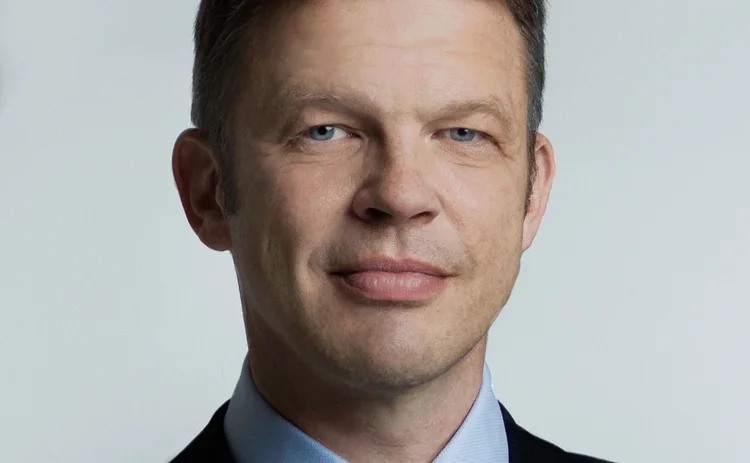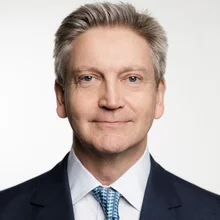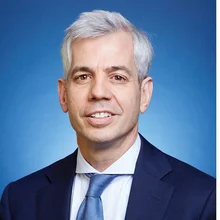
Bank risk manager of the year: Deutsche Bank
Risk Awards 2021: a leaner, smarter lender emerges from a decade of chaos

2018 may go down as the year risk effectively reclaimed Deutsche Bank – in a figurative and fairly literal sense, under new chief executive Christian Sewing, the bank’s former deputy chief risk officer.
Not before time, many would argue: in the decade following the 2008 financial crisis, Deutsche notched up more than $20 billion in fines and regulatory settlements, racked up successive years of steep losses and rattled through five chief executives. The epithet ‘good crisis, bad recovery’ barely captures the horrors the bank confronted during the time. A 2016 International Monetary Fund report labelled the bank the world’s riskiest – unfairly, perhaps – but to many, the label seemed to fit.
Barely two years later, and facing a fresh crisis in the form of Covid-19, Deutsche is a very different-looking bank – leaner, smarter and refocused on its traditional strengths in fixed income and currency trading.
Sewing’s first big strategic move was a vast de-risking exercise, taking an axe to the investment bank, pulling out of equities market-making and hiving off vast portfolios of derivatives into a new bad bank, the lender’s second. As a result, the bank entered 2020 with a conservatively positioned loan book and market risk-weighted assets (RWAs) near historic lows, allowing it to redeploy resources and capitalise on opportunities thrown up by the market turmoil wrought by the pandemic.
The bank has emerged from the Covid crisis with far lower expected credit losses than almost all of its peers. This was partly down to old-fashioned prudent lending, but also because it focused on granular, bottom-up fundamental analysis of its largest credits to set loan-loss provisioning, rather than relying solely on model-dictated numbers.
In non-financial risk – the source of so many of its woes and weighty fines in the 2010s – the bank has made big strides, argues Stuart Lewis, Deutsche’s long-standing CRO and Sewing’s one-time boss – while acknowledging the journey to cultural transformation is still incomplete.
Early on in the Covid crisis, the bank drew a large amount of scrutiny for its decision to switch the economic horizon on its International Financial Reporting Standard 9 (IFRS 9) model out from two years to three – in essence, giving corporates more time to recover from what it hopes, for most, will be a much less worse recession than the cataclysmic falls in macro indicators such as GDP would imply.
In its first-quarter results, Deutsche announced €500 million ($440 million) in set-asides for bad loans – a steep rise, but nothing like the levels seen at some of its peers. Several factors are behind this: basic differences in loan book makeup being the obvious one, with Deutsche having far lower exposure to unsecured consumer credit than any other top-tier lender.
Deutsche nailed its colours to the mast, arguing the move was the right one from a risk, revenue and regulatory perspective. There was, as the bank saw it, little use and potential harm in diverting retained earnings to provisioning, only to see it bleed back into profit and loss (P&L) over successive quarters as macro indicators bounced back.
“IFRS 9 and CECL [Current Expected Credit Loss] were not built for swings in GDP of 5% or 10%, quarter on quarter,” says Peter Yearley, chief risk officer for Deutsche’s corporate and investment bank.
“We concluded immediately this was going to create huge volatility swings in our P&L in quarters across the year, which we didn’t think was appropriate for reporting or for representation of expected losses.”

Faced with that conclusion, the bank decided to take a longer-term view on the economy’s trough-to-recovery outlook, to a degree neutralising the noise such steep quarterly falls in GDP would ordinarily imply if the contraction in economic output was permanent. Had the bank stuck with a two-year model outlook, the quarterly rise in reserves would have been significantly greater, depleting capital that could have been deployed to support clients when they needed it most, only for it to be released from provisioning when macro indicators such as GDP snapped back in the third and fourth quarters.
In the third quarter of 2020, at a time when many of its peers were sharply revising down loan-loss provisioning, the bank reported a small net increase in provisioning of €273 million – the result of a releasing €135 million from reserves for still-healthy loans, while prudently increasing it for defaulted exposures by €408 million. Indeed, in reporting full year results for 2020, many of the bank’s largest peers have already begun to release billions from loan-loss reserves.
Lewis says: “[The move] meant we didn’t deplete our capital at a time when our clients were looking to deploy it. That was part of the guidelines that the European Central Bank announced: they wanted banks not to pay dividends and to take a prudent approach with their reserves, because they were fearful that there would be insufficient capital in the system in order to go to help clients when they need it most.”
Instead of relying purely on model-dictated numbers, Lewis and his veteran credit risk team emphasised old-fashioned, bottom-up analyses of borrowers’ fundamentals, working out what the outlook would be for the worst-hit sectors such as commercial real estate and aviation. The bank had daily discussions with its biggest borrowers, seeking indications as to when drawdowns might happen, allowing it to accurately model what future drawdown might be.
That meant the bank was ready to meet what Lewis calls a “phenomenal rush for liquidity” from its clients as the crisis hit: Deutsche saw more than €20 billion in drawdowns from its revolving credit facilities in March and April, the vast majority to investment-grade names.
Sticking with a three-year methodology also gave the bank the confidence to provide early, accurate guidance to stakeholders that provisioning on loans would be between 35 and 45 basis points, a level it expects to stay true.
“I’m confident we’ll end up there,” adds Yearley, arguing that not many banks have offered such a tight degree of precision in their guidance.
Under the bonnet
The scale of Deutsche’s selloffs has seen the bank shed its title as the world’s largest derivatives dealer – a tag that might once have been a badge of pride, but came to be viewed by some as a bright warning beacon of systemic riskiness – with notionals falling another 10% in 2019.
That meant it went into the crisis leaner: in the second quarter of 2020, its average value-at-risk was €43 million, just 9% of group RWAs. That helped it navigate the market turmoil “much, much more dynamically than would have been the case otherwise”, says Bevan Cowie, Deutsche’s head of market, liquidity, valuation and model risk management.
Arguably as important was a less visible change to the bank’s risk architecture: namely, its 2019 switch to the full revaluation historical simulation methodology for its market risk VAR calculations. The approach sees the bank’s portfolios repriced daily using historical simulations over a given period of time, rather than relying on cruder proxy methods such as sensitivities-based analyses.

This switch required a lengthy front-to-back re-engineering of Deutsche’s core risk and trading book architecture, says Cowie. Repricing 2.4 million trades daily (a figure set to rise to 4 million a day in 2021) is no small computational ask, relying on more than 20 billion separate calculations per day and drawing on half a trillion data points.
The newfound granularity this offered gave the bank an edge when volatility hit in March and April, says Cowie: “As you go into an environment like we observed in March and April, having a very good sense of how our portfolio will behave is key to knowing what and how to handle the earnings implications. It means we know how to navigate that very effectively and quickly. That enabled us, particularly in the second quarter, to capitalise on the opportunities that come off the back of an event like that.”
The results bear this out. Revenues in the investment bank jumped by half to €2.7 billion in the second quarter – €2.1 billion of it driven by the bank’s core fixed income and foreign exchange trading business.
More granular oversight of traders’ positions cuts both ways, of course: coming into the crisis, the bank was able to identify troublesome spots where capital consumption remained stubbornly high.
The illiquid credit options book was a case in point, says Cowie: “The strength of full reval historical simulation really gives you a good sense of that convexity effect for a vast array of underlying scenarios. That’s one place where it really highlighted, particularly in [our] stress VAR [calculations], the capital sensitivity that you can have for out-of-the-money options. In the credit options space, we have refined the way we assess the risk and run it as a business, leveraging the visibility that we now get around that risk profile and capital implications.”
Human capital
Perhaps the biggest challenge of the last nine months, though, says Lewis, has been the human one: “not being able to get a read on people, face to face”, for instance. “It’s tough. It can mean closer support when decisions are being made.”
Many bank chiefs have stressed the importance of human capital, built up over time, as acting like a very real capital buffer in times of stress. This came to the fore during the pandemic, when executives could no longer meet face to face daily with all of their teams, and travel freely between offices – a challenge for Deutsche, with Lewis and most of his top team based in London.
Perhaps paradoxically, given the heavy turnover in the upper echelons of the bank’s management in the decade since the crisis, the risk function has been a model of stability. Lewis himself has enjoyed one of the longest tenures of any CRO at a major bank.

Having worked together through the 2008 and eurozone crises with much of his top team – including Yearly, who was head of credit for structured finance when Lewis was chief credit officer – Lewis didn’t have to devote excessive time and energy to “directing the troops”, as he puts it. That human capital has translated into very real practical benefits during the Covid working-from-home era, says Lewis: “People don’t hold back when they challenge each other here.”
In 2019, the bank moved oversight of compliance and anti-financial crime teams into the CRO’s office – a timely move, given a large number of its traders and revenue generators would soon decamp to work from home almost overnight, out of physical oversight at a time when wild P&L swings on whipsawing markets were causing hundreds of soft breaches, including a more than 1,000% VAR breach for one trading desk.
Has Deutsche seen the last of its big fines? Probably not: last month, the bank entered a $125 million deferred prosecution agreement with US watchdogs to settle allegations that it bribed foreign officials, as well as covering an unrelated attempt to rig precious metals markets.
Still, structural changes are bearing fruit, Lewis insists – and Deutsche is on the right path.
“Often, these journeys are relatively long, and I guess you might expect some challenges along the way,” he says. “But through the metrics that we look at, it certainly feels to me that we are making progress, particularly in first-line-of-defence accountability, which is of critical importance. We’re seeing more positive feedback around openness in the organisation through our employee surveys. Every year, we do a variety of surveys, where we take the organisational pulse. People are clearly more confident that they’re able to speak up if things go wrong, that they’re able to have those open discussions with the managers.”
Only users who have a paid subscription or are part of a corporate subscription are able to print or copy content.
To access these options, along with all other subscription benefits, please contact info@risk.net or view our subscription options here: http://subscriptions.risk.net/subscribe
You are currently unable to print this content. Please contact info@risk.net to find out more.
You are currently unable to copy this content. Please contact info@risk.net to find out more.
Copyright Infopro Digital Limited. All rights reserved.
As outlined in our terms and conditions, https://www.infopro-digital.com/terms-and-conditions/subscriptions/ (point 2.4), printing is limited to a single copy.
If you would like to purchase additional rights please email info@risk.net
Copyright Infopro Digital Limited. All rights reserved.
You may share this content using our article tools. As outlined in our terms and conditions, https://www.infopro-digital.com/terms-and-conditions/subscriptions/ (clause 2.4), an Authorised User may only make one copy of the materials for their own personal use. You must also comply with the restrictions in clause 2.5.
If you would like to purchase additional rights please email info@risk.net
More on Awards
Clearing house of the year: LCH
Risk Awards 2025: LCH outshines rivals in its commitment to innovation and co-operation with clearing members
Best use of machine learning/AI: CompatibL
CompatibL’s groundbreaking use of LLMs for automated trade entry earned the Best use of machine learning/AI award at the 2025 Risk Markets Technology Awards, redefining speed and reliability in what-if analytics
Markets Technology Awards 2025 winners’ review
Vendors jockeying for position in this year’s MTAs, as banks and regulators take aim at counterparty blind spots
Equity derivatives house of the year: Bank of America
Risk Awards 2025: Bank gains plaudits – and profits – with enhanced product range, including new variants of short-vol structures and equity dispersion
Law firm of the year: Linklaters
Risk Awards 2025: Law firm’s work helped buttress markets for credit derivatives, clearing and digital assets
Derivatives house of the year: UBS
Risk Awards 2025: Mega-merger expected to add $1 billion to markets revenues, via 30 integration projects
Interest rate derivatives house of the year: JP Morgan
Risk Awards 2025: Steepener hedges and Spire novations helped clients navigate shifting rates regime
Currency derivatives house of the year: UBS
Risk Awards 2025: Access to wealth management client base helped Swiss bank to recycle volatility and provide accurate pricing for a range of FX structures







